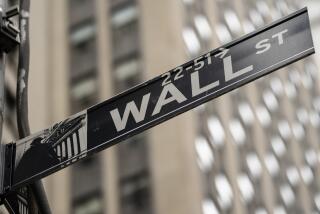Low Rates Pushing Small Investors Back Into Stocks : Securities: A trade group says individual trading activity through brokerages is the greatest since 1987.
- Share via
NEW YORK — Small investors are returning to the stock market in the biggest wave of trading since the 1987 crash.
Plunging interest rates on bank certificates of deposit and money market accounts have encouraged many individuals to seek higher returns in 1991’s solid stock market.
“The retail sector has been this year’s driving force,” said Jeffrey Schaefer, research director for the Securities Industry Assn., the industry’s main trade group.
According to new statistics, small investor activity was up 18% on the New York Stock Exchange through the first nine months of the year, while trading by big institutions and investment firms rose at a slower pace.
The SIA figures show that individual trading activity through retail brokerages is the greatest since the trade group began breaking down its statistics in 1987, and probably the highest ever.
“We find that people have money and are investing,” said John W. Bachmann, managing principal of Edward D. Jones & Co. of St. Louis, which, with more than 1,000 offices, has the nation’s biggest retail brokerage network.
“Some of the money is coming out of the banking system, where the rates are just not very attractive,” Bachmann said Monday.
According to the latest weekly survey of 100 banks by the newsletter Bank Rate Monitor, the annual yield on money market accounts--which generally consist of short-term bonds--was down to 4.86% last week. Yields on Super NOW savings accounts fell to 4.32% and six-month CDs to 5.09%. All three are at historic lows after plunging this year.
“Interest rates have come down and that has tended to direct people to conservative, high-quality stocks that pay dividends,” said Richard Ryan, a broker and first vice president with Robert W. Baird & Co. in Milwaukee.
The market is also benefiting from recessionary declines in other investments, such as real estate, and the movement of more pension and retirement money into stocks.
NYSE trading volume for the first nine months of the year was 176.9 million shares daily, up 12% from a year ago. Trading in the NASDAQ over-the-counter market, traditionally favored by individuals, is at record levels.
Net sales of shares of stock mutual funds--consisting of many individual stocks--totaled $25.5 billion in the first nine months of the year, up 27% from a year ago, according to the Investment Company Institute.
That contrasts sharply with 1988, the year after the crash, when investors withdrew $3.8 billion more money from stock funds than they invested.
Because it is based on the relative appeal of stocks, not fast-rising prices, the resurgence in trading in 1991 is fundamentally different from the bull market that preceded the ’87 crash.
The Dow Jones industrial average, the most familiar barometer of the market, posted its biggest gains early in the year during the Gulf War and has been hovering around 3,000 since April.
“If you can’t put your money in real estate and you can’t put your money in interest-bearing (accounts), where are you going to put it?” Steve Bilcharski, a 38-year-old accountant, asked while watching the electronic stock ticker at a Fidelity Investments brokerage office in Manhattan.
The interest in stocks seems based on more than whim. More Americans are trading on their own through discount brokerages. Membership in American Assn. of Individual Investors has increased by about 15,000 this year to 120,000, said John Markese, research director for the Chicago-based group.
Markese said increasing numbers of members are asking for educational materials about the stock market, and attendance at the group’s nationwide how-to seminars are up 50%.
“There’s more interest in people looking for alternative investments,” he said.
Regional investment firms, which specialize in small investors, have benefited the most from the brokerage boom, with commissions from trading up 35.6% in the first nine months of the year. That compares to a 29.7% gain for full-line firms typically based in New York, such as Merrill Lynch & Co. and Shearson Lehman Bros.
Back in the Market Trading by small investors is at its highest level since the 1987 stock market crash, and individuals are accounting for a bigger percentage of all trades. Professional ‘87: 66.7 ‘88: 69.3 ‘89: 62.2 ‘90: 60.1 ‘91*: 57.6 Individual ‘87: 33 ‘88: 29.3 ‘89: 37.8 ‘90: 39.9 ‘91*: 42.4 Stock activity Purchases and sales of stock by individual investors: 1991 New York Stock Exchange average daily share activity in millions of shares ‘87: 89.6 ‘88: 71.7 ‘89: 93.3 ‘90: 94.8 ‘91*: 112 * Figures up to September, 1991 Source: Securities Industry Assn.
More to Read
Inside the business of entertainment
The Wide Shot brings you news, analysis and insights on everything from streaming wars to production — and what it all means for the future.
You may occasionally receive promotional content from the Los Angeles Times.










